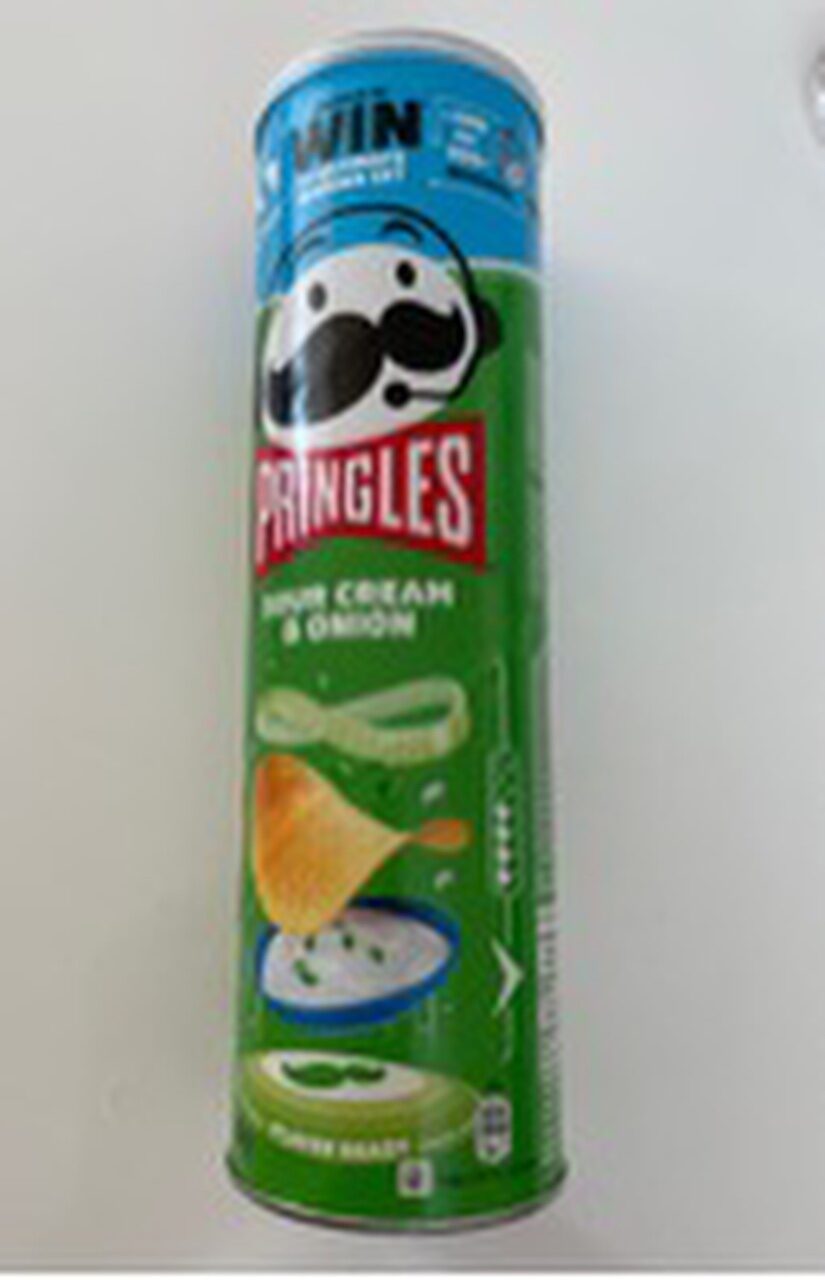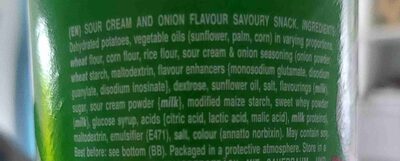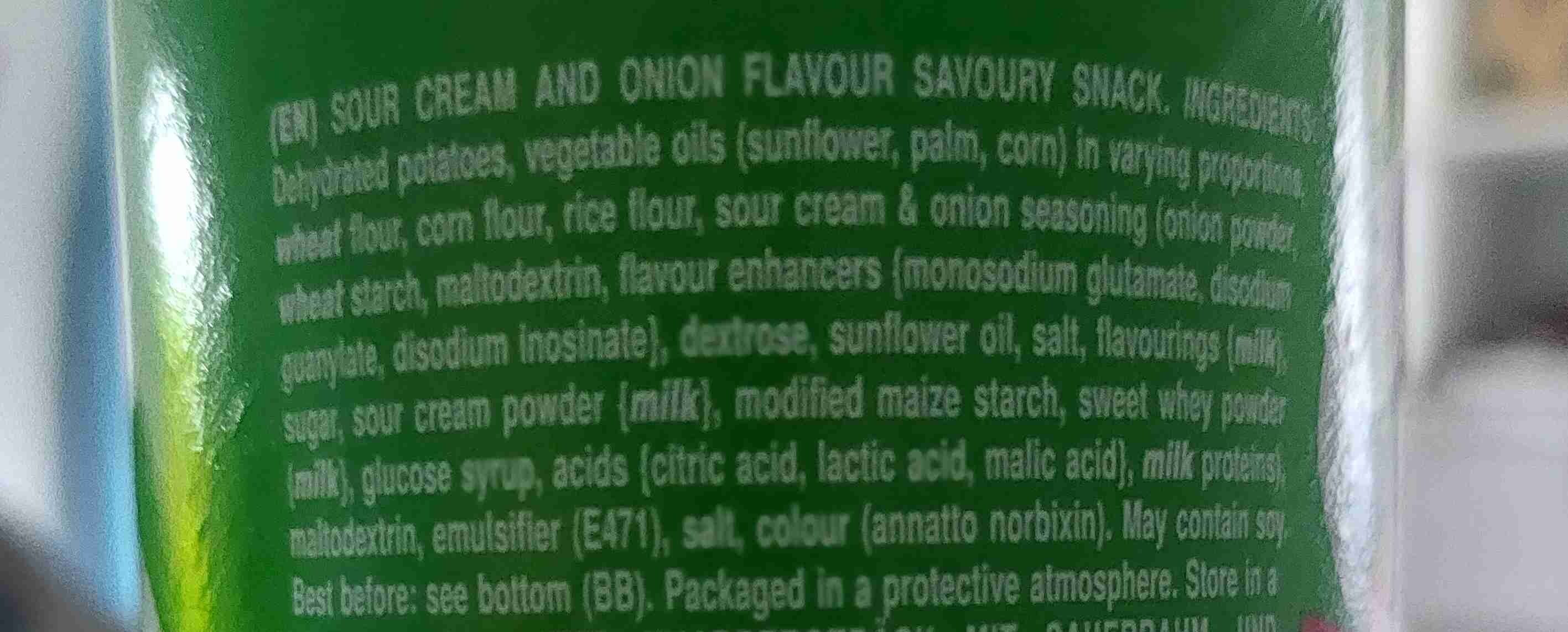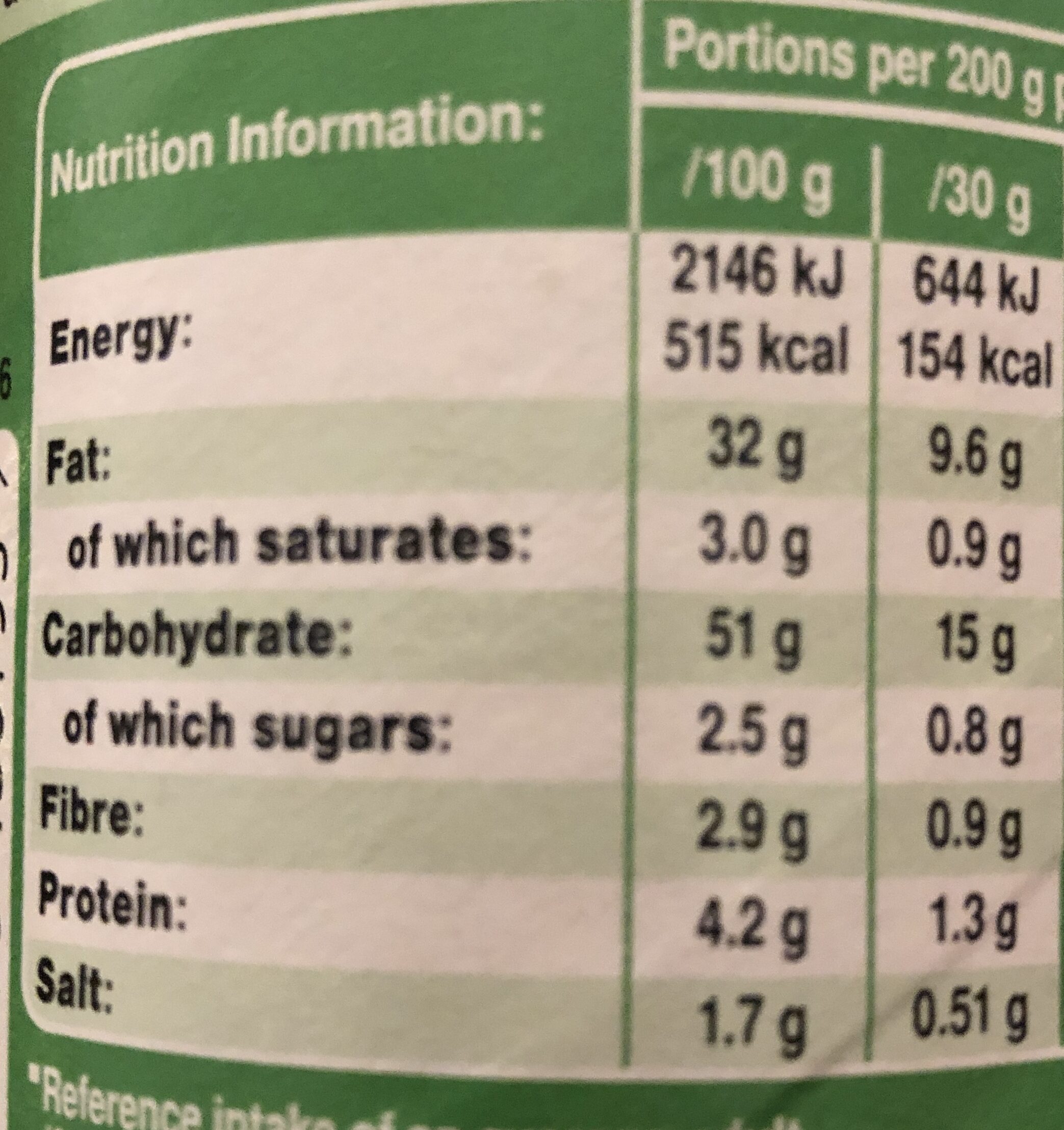Help us make food transparency the norm!
As a non-profit organization, we depend on your donations to continue informing consumers around the world about what they eat.
The food revolution starts with you!
Sour Cream & Onion - Pringles - 200 g
Sour Cream & Onion - Pringles - 200 g
This product page is not complete. You can help to complete it by editing it and adding more data from the photos we have, or by taking more photos using the app for Android or iPhone/iPad. Thank you!
×
Some of the data for this product has been provided directly by the manufacturer KELLOGG'S.
Côd bar: 5053990138753 (EAN / EAN-13)
Common name: Sour cream and onion flavour savoury snack
Quantity: 200 g
Packaging: en:Composite-tube, en:Container, en:Dose, en:Dose(n), en:Pet-lid, en:Päckchen
Brandiau: Pringles, Pringles - Kellogg
Categorïau: en:Plant-based foods and beverages, en:Plant-based foods, en:Snacks, en:Cereals and potatoes, en:Salty snacks, en:Appetizers, en:Chips and fries, en:Crisps, en:Potato crisps, en:Flavoured potato crisps, en:Salty snacks made from potato
Labels, certifications, awards: en:Vegetarisch
Origin of ingredients: en:Unspecified
Link to the product page on the official site of the producer: https://www.pringles.com/de/products/fla...
Countries where sold: Awstria, Gwlad Belg, Ffrainc, Yr Almaen, Moroco, Sbaen, Sweden, Y Swistir, Y Deyrnas Unedig
Matching with your preferences
Health
Cynhwysion
-
35 ingredients
Saesneg: dehydrated potatoes, vegetable oils (sunflower, palm, corn) in varying proportions wheat flour, corn flour, rice flour, sour cream & onion seasoning (onion powder wheat starch, maltodextrin, flavour enhancers (monosodium glutamate, disodiu guanylate, disodium inosinate), dextrose, sunflower oil, salt, flavourings (milk), sugar, sour cream powder (milk), modified maize starch, sweet whey powder (milk), glucose syrup, acids (citric acid, lactic acid, malic acid), milk proteins maltodextrin, emulsifier (e471), salt, colour (annatto norbixin). may contain soy best before: see bottom (bb). packaged in a protective atmosphere. store in aAlergenau: en:Gluten, en:Milk
Food processing
-
Ultra processed foods
Elements that indicate the product is in the en:4 - Ultra processed food and drink products group:
- Ychwanegyn: E160b
- Ychwanegyn: E471
- Ychwanegyn: E621
- Ychwanegyn: E631
- Ingredient: Colour
- Ingredient: Dextrose
- Ingredient: Emulsifier
- Ingredient: Flavour enhancer
- Ingredient: Flavouring
- Ingredient: Glucose
- Ingredient: Glucose syrup
- Ingredient: Maltodextrin
- Ingredient: Maidd
Food products are classified into 4 groups according to their degree of processing:
- Unprocessed or minimally processed foods
- Processed culinary ingredients
- Processed foods
- Ultra processed foods
The determination of the group is based on the category of the product and on the ingredients it contains.
Ychwanegion
-
E270 - Asid lactig
Lactic acid: Lactic acid is an organic compound with the formula CH3CH-OH-COOH. In its solid state, it is white and water-soluble. In its liquid state, it is colorless. It is produced both naturally and synthetically. With a hydroxyl group adjacent to the carboxyl group, lactic acid is classified as an alpha-hydroxy acid -AHA-. In the form of its conjugate base called lactate, it plays a role in several biochemical processes. In solution, it can ionize a proton from the carboxyl group, producing the lactate ion CH3CH-OH-CO−2. Compared to acetic acid, its pKa is 1 unit less, meaning lactic acid deprotonates ten times more easily than acetic acid does. This higher acidity is the consequence of the intramolecular hydrogen bonding between the α-hydroxyl and the carboxylate group. Lactic acid is chiral, consisting of two optical isomers. One is known as L--+--lactic acid or -S--lactic acid and the other, its mirror image, is D--−--lactic acid or -R--lactic acid. A mixture of the two in equal amounts is called DL-lactic acid, or racemic lactic acid. Lactic acid is hygroscopic. DL-lactic acid is miscible with water and with ethanol above its melting point which is around 17 or 18 °C. D-lactic acid and L-lactic acid have a higher melting point. In animals, L-lactate is constantly produced from pyruvate via the enzyme lactate dehydrogenase -LDH- in a process of fermentation during normal metabolism and exercise. It does not increase in concentration until the rate of lactate production exceeds the rate of lactate removal, which is governed by a number of factors, including monocarboxylate transporters, concentration and isoform of LDH, and oxidative capacity of tissues. The concentration of blood lactate is usually 1–2 mM at rest, but can rise to over 20 mM during intense exertion and as high as 25 mM afterward. In addition to other biological roles, L-lactic acid is the primary endogenous agonist of hydroxycarboxylic acid receptor 1 -HCA1-, which is a Gi/o-coupled G protein-coupled receptor -GPCR-.In industry, lactic acid fermentation is performed by lactic acid bacteria, which convert simple carbohydrates such as glucose, sucrose, or galactose to lactic acid. These bacteria can also grow in the mouth; the acid they produce is responsible for the tooth decay known as caries. In medicine, lactate is one of the main components of lactated Ringer's solution and Hartmann's solution. These intravenous fluids consist of sodium and potassium cations along with lactate and chloride anions in solution with distilled water, generally in concentrations isotonic with human blood. It is most commonly used for fluid resuscitation after blood loss due to trauma, surgery, or burns.Source: Wikipedia (Saesneg)
-
E296
Malic acid: Malic acid is an organic compound with the molecular formula C4H6O5. It is a dicarboxylic acid that is made by all living organisms, contributes to the pleasantly sour taste of fruits, and is used as a food additive. Malic acid has two stereoisomeric forms -L- and D-enantiomers-, though only the L-isomer exists naturally. The salts and esters of malic acid are known as malates. The malate anion is an intermediate in the citric acid cycle.Source: Wikipedia (Saesneg)
-
E330 - Asid sitrig
Citric acid: Citric acid is a weak organic acid that has the chemical formula C6H8O7. It occurs naturally in citrus fruits. In biochemistry, it is an intermediate in the citric acid cycle, which occurs in the metabolism of all aerobic organisms. More than a million tons of citric acid are manufactured every year. It is used widely as an acidifier, as a flavoring and chelating agent.A citrate is a derivative of citric acid; that is, the salts, esters, and the polyatomic anion found in solution. An example of the former, a salt is trisodium citrate; an ester is triethyl citrate. When part of a salt, the formula of the citrate ion is written as C6H5O3−7 or C3H5O-COO-3−3.Source: Wikipedia (Saesneg)
-
E471
Mono- and diglycerides of fatty acids: Mono- and diglycerides of fatty acids -E471- refers to a food additive composed of diglycerides and monoglycerides which is used as an emulsifier. This mixture is also sometimes referred to as partial glycerides.Source: Wikipedia (Saesneg)
-
E621
Monosodium glutamate: Monosodium glutamate -MSG, also known as sodium glutamate- is the sodium salt of glutamic acid, one of the most abundant naturally occurring non-essential amino acids. Glutamic acid is found naturally in tomatoes, grapes, cheese, mushrooms and other foods.MSG is used in the food industry as a flavor enhancer with an umami taste that intensifies the meaty, savory flavor of food, as naturally occurring glutamate does in foods such as stews and meat soups. It was first prepared in 1908 by Japanese biochemist Kikunae Ikeda, who was trying to isolate and duplicate the savory taste of kombu, an edible seaweed used as a base for many Japanese soups. MSG as a flavor enhancer balances, blends, and rounds the perception of other tastes.The U.S. Food and Drug Administration has given MSG its generally recognized as safe -GRAS- designation. A popular belief is that large doses of MSG can cause headaches and other feelings of discomfort, known as "Chinese restaurant syndrome," but double-blind tests fail to find evidence of such a reaction. The European Union classifies it as a food additive permitted in certain foods and subject to quantitative limits. MSG has the HS code 29224220 and the E number E621.Source: Wikipedia (Saesneg)
-
E631
Disodium inosinate: Disodium inosinate -E631- is the disodium salt of inosinic acid with the chemical formula C10H11N4Na2O8P. It is used as a food additive and often found in instant noodles, potato chips, and a variety of other snacks. Although it can be obtained from bacterial fermentation of sugars, it is often commercially prepared from animal sources.Source: Wikipedia (Saesneg)
Ingredients analysis
-
en:Palm oil
Ingredients that contain palm oil: en:Palm oil
-
en:Non-vegan
Non-vegan ingredients: en:Sour cream, en:Sweet whey powderSome ingredients could not be recognized.
We need your help!
You can help us recognize more ingredients and better analyze the list of ingredients for this product and others:
- Edit this product page to correct spelling mistakes in the ingredients list, and/or to remove ingredients in other languages and sentences that are not related to the ingredients.
- Add new entries, synonyms or translations to our multilingual lists of ingredients, ingredient processing methods, and labels.
If you would like to help, join the #ingredients channel on our Slack discussion space and/or learn about ingredients analysis on our wiki. Thank you!
-
en:Vegetarian status unknown
Unrecognized ingredients: en:corn-in-varying-proportions-wheat-flour, en:sour-cream-and-onion-seasoning, en:onion-powder-wheat-starch, en:disodiu-guanylate, en:milk-proteins-maltodextrin, en:best-before, en:see-bottom, en:store-in-aSome ingredients could not be recognized.
We need your help!
You can help us recognize more ingredients and better analyze the list of ingredients for this product and others:
- Edit this product page to correct spelling mistakes in the ingredients list, and/or to remove ingredients in other languages and sentences that are not related to the ingredients.
- Add new entries, synonyms or translations to our multilingual lists of ingredients, ingredient processing methods, and labels.
If you would like to help, join the #ingredients channel on our Slack discussion space and/or learn about ingredients analysis on our wiki. Thank you!
-
Details of the analysis of the ingredients
We need your help!
Some ingredients could not be recognized.
We need your help!
You can help us recognize more ingredients and better analyze the list of ingredients for this product and others:
- Edit this product page to correct spelling mistakes in the ingredients list, and/or to remove ingredients in other languages and sentences that are not related to the ingredients.
- Add new entries, synonyms or translations to our multilingual lists of ingredients, ingredient processing methods, and labels.
If you would like to help, join the #ingredients channel on our Slack discussion space and/or learn about ingredients analysis on our wiki. Thank you!
en: potatoes, sunflower vegetable oils, palm vegetable oils, corn) in varying proportions wheat flour, corn flour, rice flour, sour cream and onion seasoning, onion powder wheat starch, maltodextrin, flavour enhancers (monosodium glutamate, disodiu guanylate, disodium inosinate), dextrose, sunflower oil, salt, flavourings, sugar, sour cream, modified maize starch, sweet whey powder, glucose syrup, acids (citric acid, lactic acid, malic acid), milk proteins maltodextrin, emulsifier (e471), salt, colour (annatto norbixin), best before (see bottom, store in a)- potatoes -> en:potato - vegan: yes - vegetarian: yes - ciqual_food_code: 4003 - percent_min: 4 - percent_max: 100
- sunflower vegetable oils -> en:sunflower-oil - vegan: yes - vegetarian: yes - from_palm_oil: no - ciqual_food_code: 17440 - percent_min: 0 - percent_max: 50
- palm vegetable oils -> en:palm-oil - vegan: yes - vegetarian: yes - from_palm_oil: yes - ciqual_food_code: 16129 - percent_min: 0 - percent_max: 33.3333333333333
- corn) in varying proportions wheat flour -> en:corn-in-varying-proportions-wheat-flour - percent_min: 0 - percent_max: 25
- corn flour -> en:corn-flour - vegan: yes - vegetarian: yes - ciqual_food_code: 9545 - percent_min: 0 - percent_max: 20
- rice flour -> en:rice-flour - vegan: yes - vegetarian: yes - ciqual_food_code: 9520 - percent_min: 0 - percent_max: 16.6666666666667
- sour cream and onion seasoning -> en:sour-cream-and-onion-seasoning - percent_min: 0 - percent_max: 14.2857142857143
- onion powder wheat starch -> en:onion-powder-wheat-starch - percent_min: 0 - percent_max: 12.5
- maltodextrin -> en:maltodextrin - vegan: yes - vegetarian: yes - percent_min: 0 - percent_max: 11.1111111111111
- flavour enhancers -> en:flavour-enhancer - percent_min: 0 - percent_max: 10
- monosodium glutamate -> en:e621 - vegan: yes - vegetarian: yes - percent_min: 0 - percent_max: 10
- disodiu guanylate -> en:disodiu-guanylate - percent_min: 0 - percent_max: 5
- disodium inosinate -> en:e631 - vegan: maybe - vegetarian: maybe - percent_min: 0 - percent_max: 3.33333333333333
- dextrose -> en:dextrose - vegan: yes - vegetarian: yes - ciqual_proxy_food_code: 31016 - percent_min: 0 - percent_max: 9.09090909090909
- sunflower oil -> en:sunflower-oil - vegan: yes - vegetarian: yes - from_palm_oil: no - ciqual_food_code: 17440 - percent_min: 0 - percent_max: 8.33333333333333
- salt -> en:salt - vegan: yes - vegetarian: yes - ciqual_food_code: 11058 - percent_min: 0 - percent_max: 1.4
- flavourings -> en:flavouring - vegan: maybe - vegetarian: maybe - percent_min: 0 - percent_max: 1.4
- sugar -> en:sugar - vegan: yes - vegetarian: yes - ciqual_proxy_food_code: 31016 - percent_min: 0 - percent_max: 1.4
- sour cream -> en:sour-cream - vegan: no - vegetarian: yes - ciqual_food_code: 19402 - percent_min: 0 - percent_max: 1.4
- modified maize starch -> en:modified-corn-starch - vegan: yes - vegetarian: yes - ciqual_food_code: 9510 - percent_min: 0 - percent_max: 1.4
- sweet whey powder -> en:sweet-whey-powder - vegan: no - vegetarian: maybe - percent_min: 0 - percent_max: 1.4
- glucose syrup -> en:glucose-syrup - vegan: yes - vegetarian: yes - ciqual_proxy_food_code: 31016 - percent_min: 0 - percent_max: 1.4
- acids -> en:acid - percent_min: 0 - percent_max: 1.4
- citric acid -> en:e330 - vegan: yes - vegetarian: yes - percent_min: 0 - percent_max: 1.4
- lactic acid -> en:e270 - vegan: yes - vegetarian: yes - percent_min: 0 - percent_max: 0.7
- malic acid -> en:e296 - vegan: yes - vegetarian: yes - percent_min: 0 - percent_max: 0.466666666666667
- milk proteins maltodextrin -> en:milk-proteins-maltodextrin - percent_min: 0 - percent_max: 1.4
- emulsifier -> en:emulsifier - percent_min: 0 - percent_max: 1.4
- e471 -> en:e471 - vegan: maybe - vegetarian: maybe - from_palm_oil: maybe - percent_min: 0 - percent_max: 1.4
- salt -> en:salt - vegan: yes - vegetarian: yes - ciqual_food_code: 11058 - percent_min: 0 - percent_max: 1.4
- colour -> en:colour - percent_min: 0 - percent_max: 1.4
- annatto norbixin -> en:e160b - vegan: yes - vegetarian: yes - percent_min: 0 - percent_max: 1.4
- best before -> en:best-before - percent_min: 0 - percent_max: 1.4
- see bottom -> en:see-bottom - percent_min: 0 - percent_max: 1.4
- store in a -> en:store-in-a - percent_min: 0 - percent_max: 0.7
Nutrition
-
Poor nutritional quality
This product is not considered a beverage for the calculation of the Nutri-Score.
Positive points: 3
- Proteins: 2 / 5 (value: 4.6, rounded value: 4.6)
- Fiber: 3 / 5 (value: 2.9, rounded value: 2.9)
- Fruits, vegetables, nuts, and colza/walnut/olive oils: 0 / 5 (value: 0, rounded value: 0)
Negative points: 14
- Energy: 6 / 10 (value: 2237, rounded value: 2237)
- Sugars: 0 / 10 (value: 2.4, rounded value: 2.4)
- Saturated fat: 2 / 10 (value: 3, rounded value: 3)
- Sodium: 6 / 10 (value: 560, rounded value: 560)
The points for proteins are not counted because the negative points are greater or equal to 11.
Nutritional score: (14 - 3)
Nutri-Score:
-
Nutrient levels
-
Braster in high quantity (32%)
What you need to know- A high consumption of fat, especially saturated fats, can raise cholesterol, which increases the risk of heart diseases.
Recommendation: Limit the consumption of fat and saturated fat- Choose products with lower fat and saturated fat content.
-
Saturated fat in moderate quantity (3%)
What you need to know- A high consumption of fat, especially saturated fats, can raise cholesterol, which increases the risk of heart diseases.
Recommendation: Limit the consumption of fat and saturated fat- Choose products with lower fat and saturated fat content.
-
Siwgr in low quantity (2.4%)
What you need to know- A high consumption of sugar can cause weight gain and tooth decay. It also augments the risk of type 2 diabetes and cardio-vascular diseases.
Recommendation: Limit the consumption of sugar and sugary drinks- Sugary drinks (such as sodas, fruit beverages, and fruit juices and nectars) should be limited as much as possible (no more than 1 glass a day).
- Choose products with lower sugar content and reduce the consumption of products with added sugars.
-
Halen in moderate quantity (1.4%)
What you need to know- A high consumption of salt (or sodium) can cause raised blood pressure, which can increase the risk of heart disease and stroke.
- Many people who have high blood pressure do not know it, as there are often no symptoms.
- Most people consume too much salt (on average 9 to 12 grams per day), around twice the recommended maximum level of intake.
Recommendation: Limit the consumption of salt and salted food- Reduce the quantity of salt used when cooking, and don't salt again at the table.
- Limit the consumption of salty snacks and choose products with lower salt content.
-
-
Nutrition facts
Nutrition facts As sold
for 100 g / 100 mlAs sold
per serving (30g)Compared to: en:Salty snacks made from potato Egni 2,237 kj
(536 kcal)671 kj
(161 kcal)+4% Braster 32 g 9.6 g +6% Saturated fat 3 g 0.9 g -9% Carbohydrates 56 g 16.8 g +2% Siwgr 2.4 g 0.72 g -22% Fiber 2.9 g 0.87 g -5% Protin 4.6 g 1.38 g -4% Halen 1.4 g 0.42 g -8% Fruits‚ vegetables‚ nuts and rapeseed‚ walnut and olive oils (estimate from ingredients list analysis) 0 % 0 %
Environment
-
Eco-Score C - Moderate environmental impact
The Eco-Score is an experimental score that summarizes the environmental impacts of food products.→ The Eco-Score was initially developped for France and it is being extended to other European countries. The Eco-Score formula is subject to change as it is regularly improved to make it more precise and better suited to each country.Life cycle analysis
-
Average impact of products of the same category: A (Score: 87/100)
Categori: Salty snacks, made from potato
Categori: Salty snacks, made from potato
- PEF environmental score: 0.22 (the lower the score, the lower the impact)
- including impact on climate change: 1.59 kg CO2 eq/kg of product
Stage Impact Agriculture
59.7 %Processing
22.4 %Packaging
10.6 %Transportation
5.2 %Distribution
2.2 %Consumption
0.0 %
Bonuses and maluses
-
Origins of ingredients with a high impact
Malus: -5
Environmental policy: -5
Transportation: 0
Origin of the product and/or its ingredients % of ingredients Impact Unspecified 100 %High Barbados 0 %Medium
-
Ingredients that threatens species
Malus: -10
Contains palm oil
Tropical forests in Asia, Africa and Latin America are destroyed to create and expand oil palm tree plantations. The deforestation contributes to climate change, and it endangers species such as the orangutan, the pigmy elephant and the Sumatran rhino.
-
Packaging with a high impact
Malus: -15
Shape Material Recycling Impact Unknown HDPE High Unknown PP High ⚠ ️ The information about the packaging of this product is not sufficiently precise (exact shapes and materials of all components of the packaging).⚠ ️ For a more precise calculation of the Eco-Score, you can modify the product page and add them.
If you are the manufacturer of this product, you can send us the information with our free platform for producers.
Eco-Score for this product
-
Impact for this product: C (Score: 57/100)
Gynnyrch: Sour Cream & Onion - Pringles - 200 g
Life cycle analysis score: 87
Sum of bonuses and maluses: -30
Final score: 57/100
-
Carbon footprint
-
Equal to driving 0.8 km in a petrol car
159 g CO² per 100g of product
The carbon emission figure comes from ADEME's Agribalyse database, for the category: Salty snacks, made from potato (Source: ADEME Agribalyse Database)
Stage Impact Agriculture
53.6 %Processing
18.8 %Packaging
17.7 %Transportation
8.7 %Distribution
1.2 %Consumption
0.0 %
Packaging
-
Packaging with a high impact
-
Packaging parts
(HDPE)
(PP)
-
Packaging materials
Material % Packaging weight Packaging weight per 100 g of product Plastic
-
Transportation
-
Origins of ingredients
Origins of ingredients with a high impact
Origin of the product and/or its ingredients % of ingredients Impact Unspecified 100 %High Barbados 0 %Medium
Threatened species
-
Contains palm oil
Drives deforestation and threatens species such as the orangutan
Tropical forests in Asia, Africa and Latin America are destroyed to create and expand oil palm tree plantations. The deforestation contributes to climate change, and it endangers species such as the orangutan, the pigmy elephant and the Sumatran rhino.
Other information
Conservation conditions: À conserver dans un endroit sec
Customer service: Service Conseil Consommateurs, Kellogg's Produits Alimentaires S.A.S. - Immeuble Neptune - 1 rue Galilée 93160 Noisy-le-Grand (France)
Report a problem
-
Incomplete or incorrect information?
Category, labels, ingredients, allergens, nutritional information, photos etc.
If the information does not match the information on the packaging, please complete or correct it. Open Food Facts is a collaborative database, and every contribution is useful for all.
Data sources
The manufacturer KELLOGG'S uses CodeOnline Food to automatically transmit data and photos for its products.
Manufacturers can use the Open Food Facts free plaform for producers to access and complete this data, and to obtain reports, analysis and product improvements opportunities (e.g. better Nutri-Score).
Product added on gan kiliweb
Last edit of product page on gan thaialagata.
Golygwyd y tudalen cynnyrch hefyd gan akitainu, charlesnepote, chevalstar, countrybot, date-limite-app, duhowpi, ecoscore-impact-estimator, geraldine76, gourmet, grumpf, halal-app-chakib, inf, jumati, livlakaemper, musarana, off.6ddca595-60dd-4ecb-bc0a-ec319f8416b1, openfoodfacts-contributors, org-kellogg-s, packbot, prepperapp, scanbot, smoothie-app, swipe-studio, tacite, tacite-mass-editor, telperion87, yuka.SG9VUUhweFJyYWhiZ1BjZXdBMk81djByNW8zNVlGT1NCcklwSVE9PQ, yuka.U3F3YkRJZ0N0UE5ScC9BdTdrTC8yY2xRM3NXamRGR3FJTlE4SVE9PQ, yuka.VjRaY0U3VllnOEVoa1BGazF6LzZwZGxKeTVDUUJsenVjTFFUSWc9PQ, yuka.WTZZYU1xTUdpYUFIdnZNU3dCcVArZkoxbXAyMURYenBKdW9NSVE9PQ, yuka.WllNa0U0czg5cUFxeThVQnd6S055TmRTM3JDS1VFSHFLL01BSVE9PQ, yuka.YkwwK0NZUW1wL2dTa2NVRTFFS0w5Y2hSMlllUFJYK0tGdVpLSVE9PQ, yuka.ZnF3aFBmb05pOUF5dU0wVTFCbi8vdmhKOWE2RWVEMnNNZXMxSVE9PQ.











